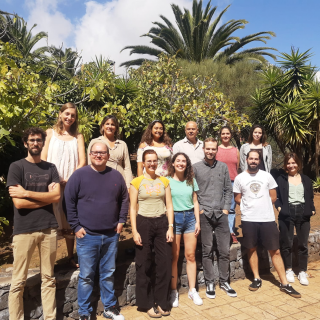Bibcode
Walo-Martín, Daniel; Pérez, Isabel; Grand, Robert J. J.; Falcón-Barroso, Jesús; Pinna, Francesca; Martig, Marie
Referencia bibliográfica
Monthly Notices of the Royal Astronomical Society
Fecha de publicación:
9
2021
Número de citas
5
Número de citas referidas
5
Descripción
The connection between the Stellar Velocity Ellipsoid (SVE) and the dynamical evolution of galaxies has been a matter of debate in the last years and there is no clear consensus whether different heating agents (e.g. spiral arms, giant molecular clouds, bars and mergers) leave clear detectable signatures in the present day kinematics. Most of these results are based on a single and global SVE and have not taken into account that these agents do not necessarily equally affect all regions of the stellar disc. We study the two-dimensional (2D) spatial distribution of the SVE across the stellar discs of Auriga galaxies, a set of high resolution magnetohydrodynamical cosmological zoom-in simulations, to unveil the connection between local and global kinematic properties in the disc region. We find very similar, global, σz/σr = 0.80 ± 0.08 values for galaxies of different Hubble types. This shows that the global properties of the SVE at z = 0 are not a good indicator of the heating and cooling events experienced by galaxies. We also find that similar σz/σr radial profiles are obtained through different combinations of σz and σr trends: at a local level, the vertical and radial components can evolve differently, leading to similar σz/σr profiles at z = 0. By contrast, the 2D spatial distribution of the SVE varies a lot more from galaxy to galaxy. Present day features in the SVE spatial distribution may be associated with specific interactions such as fly-by encounters or the accretion of low mass satellites even in the cases when the global SVE is not affected. The stellar populations decomposition reveals that young stellar populations present colder and less isotropic SVEs and more complex 2D distributions than their older and hotter counterparts.
Proyectos relacionados

Huellas de la Formación de las Galaxias: Poblaciones estelares, Dinámica y Morfología
Bienvenida a la página web del g rupo de investigación Traces of Galaxy Formation. Somos un grupo de investigación amplio, diverso y muy activo cuyo objetivo principal es entender la formación de galaxias en el Universo de una manera lo más completa posible. Con el estudio detellado de las poblaciones estelares como bandera, estamos constantemente
Ignacio
Martín Navarro